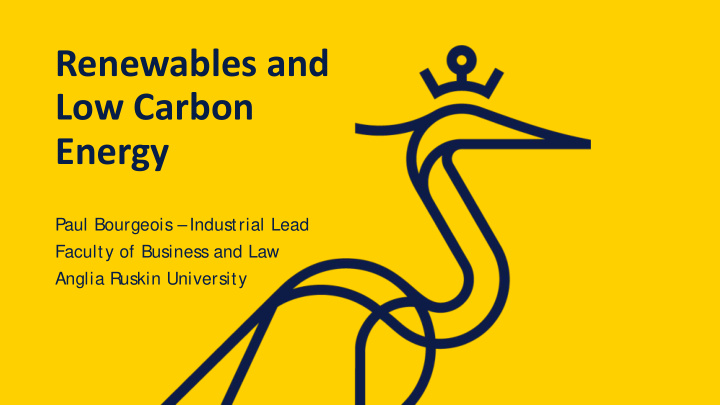



Renewables and Low Carbon Energy Paul Bourgeois –Industrial Lead Faculty of Business and Law Anglia Ruskin University
Policy context Industrial Strategy • Four Grand Challenges Clean Growth Strategy • Max. UK industry potential • CO 2 targets at lowest net cost Local Energy East Strategy • BEIS funded 2018 • Co-benefits
Local Energy priorities Retrofit Clean, smart, Demand Reduction flexible local power Local Energy Priorities Policy & Strategy Low carbon heat Low carbon transport
The Energy Transition • Driven by: resilience, affordability and carbon reduction • Local authorities have many key roles in the transition • Economic • S ocial • Environmental • Options appraisal affected by local and national factors
Energy conservation, reduction & efficiency • Energy hierarchy - quick paybacks possible • Building fabric –construction, insulation, glazing • New build and retrofit • Good design can reduce energy demand • On site monitoring and control • Consumption –lighting, equipment, services • How we use buildings –more energy efficient behaviours can deliver significant improvement
Clean energy generation
Switching to electric vehicles • The next ten years will see the car market tip from internal combustion to EV • Production are costs coming down and battery performance increase • Charging network is not sufficiently advanced to remove some of the barriers
Case Studies
Storage • Emerging technologies to store power and heat • Helping to address unwanted variability on the power network • Can generate revenue savings and income –storing low cost energy to be used when its expensive
Decarbonisation of heat • Fuel poverty • Heat networks, e.g. Swaffham Prior • Replacing heating in homes and businesses that cannot connect to a heat network • Using the gas grid – biogas and hydrogen • IRENES Interreg Project
Understanding the net zero process • Quantifying the endeavour • Domestic, Transport, Agriculture, Food Processing sector and Energy sector • Baseline agreement and target setting • Priority assessment • Delivery Plan • Identification and allocation of resources
Source: Prof A. Lovett, UEA
Support available and relevant projects • Greater S outh East Energy Hub (BEIS funded) • New Anglia LEP –www.energyhub.org.uk • Ashden Co-benefit Tool (free to download) • www.ashden.org/ programmes/ co-benefits • Local authority S CATTER tool (BEIS funded) • https:/ / scattercities.com • Green Finance • Community Municipal Bonds - http:/ / socialres.eu • Financial Incentives R esearch Proj ect (BEIS funded) • IRENES Proj ect (Interreg Europe funded) • www.interregeurope.eu/ irenes
Understanding the options • Climate sensitive investment and procurement • Direct investment and return • Co-investment and shared return • Community investment and public benefit • S upporting business and community resilience to nexus shocks
Many thanks paul.bourgeois@ anglia.ac.uk 07715 408407
Recommend
More recommend